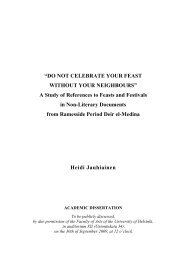BIA
bia51
bia51
Create successful ePaper yourself
Turn your PDF publications into a flip-book with our unique Google optimized e-Paper software.
JUIN 2015<br />
But only now is it becoming known the extent<br />
to which dogs served this latter role — eight<br />
million times over.<br />
That is the number of dead animals, most<br />
of them dogs, estimated to have laid in the<br />
catacombs of Anubis around Saqqâra, one of<br />
Egypt’s most historic and oft-visited sites,<br />
according to a group of British researchers.<br />
While such mass burials aren’t unprecedented,<br />
given the numerous animal cults of ancient<br />
Egypt, this one’s scale makes it unique.<br />
“We’re very pleased and somewhat surprised<br />
by the results,” the project’s director Paul<br />
NICHOLSON from Cardiff University’s School of<br />
History, Archaeology and Religion said<br />
Saturday. “We hadn’t expected that there would<br />
be so many animals, and it opens up a new<br />
series of questions.” One question that experts<br />
can at least partially answer is why an Egyptian<br />
might have brought an animal, dead or alive,<br />
to such a place.<br />
NICHOLSON, who has been studying animal<br />
cults since the 1990s, explains that people<br />
wouldn’t have come simply to kill or even bury<br />
an animal so much as allow it to move onto a<br />
different plane. A dog, especially, would be a<br />
good fit because it might then interact with<br />
Anubis, an ancient Egyptian god of the dead<br />
depicted with the body of a man and head of<br />
a dog or, its close relative, a jackal. “The<br />
important thing was to provide a representation<br />
of the god with a fitting burial,” NICHOLSON said.<br />
“It’s not some sort of blood sacrifice. It’s a<br />
religious act that’s done for the best possible<br />
motive.”<br />
The animal’s owner would hope that, by<br />
doing this, “some good will come to you,” the<br />
Wales-based Egyptologist noted. “Maybe you’re<br />
hoping that the animal will help someone in<br />
your family who has died recently (so that)<br />
Anubis will take care of that (relative).” Just as<br />
Egyptians’ view of Anubis, and dogs, has been<br />
common knowledge for some time, so too have<br />
the dog catacombs of Anubis. This includes a<br />
map from 1897 that shows their location<br />
clearly marked.<br />
Still, most of the focus was on temples<br />
outside the catacomb. Until, that is, NICHOLSON’s<br />
team — with the support and help from Egypt’s<br />
Supreme Council of Antiquities and sponsorship<br />
from National Geographic — began working on<br />
the Saqqâra site around 2009 and began<br />
exploring deep inside. They found a series of<br />
unadorned tunnels, in some cases filled with<br />
animal remains and in other cases cleared out.<br />
(NICHOLSON speculated that some might have<br />
been taken out for use in fertilizers, as has<br />
been done with other animal remains.)<br />
Those that they found were wrapped in<br />
bandages and mummified, including some with<br />
a resin applied. One shouldn’t imagine an<br />
ornate King Tut, though: They were likely<br />
stacked on top of each other and “survived<br />
very badly,” NICHOLSON said. “It would be quite<br />
difficult to easily find complete, nicely wrapped<br />
mummies,” he added. “What you have got is<br />
the decayed remains of the mummies.”<br />
To estimate how many there are, the team<br />
took a sample and extrapolated from there<br />
how many likely filled up the catacomb. One<br />
reason the number is so high is because many<br />
of the animals were very small; while there<br />
some were mature and likely had full lives,<br />
NICHOLSON speculated that some were “being<br />
especially bred for the cult.” The catacombs<br />
are believed to date from between roughly 750<br />
to 30 B.C., up to the time Egypt’s society was<br />
interacting more and more with those of<br />
Europe, including ancient Greece and Rome.<br />
A summary of the Cardiff team’s findings<br />
was published this week in the journal<br />
“Antiquity”. NICHOLSON and his co-authors,<br />
Salima IKRAM and Steve MILLS, are now working<br />
on a more complete study. And the work<br />
continues at the Saqqâra site, which includes<br />
other animal catacombs and many monuments<br />
like the step pyramid of Djoser, as well as in<br />
laboratories to discover more about the animal<br />
remains, such as patterns of sex and age.<br />
“We are very curious about where the<br />
animals came from,” NICHOLSON said. “We’re<br />
learning quite a bit about the Egyptians’<br />
interactions with animals. It’s an exciting thing.”<br />
(“Eight million mummified animals, mostly dogs,<br />
in catacombs at Egypt site”, Egypt Independent,<br />
June 22, 2015. Voir également « Découverte de<br />
8 millions de momies d’animaux momifiés »,<br />
Ruz al-Yûsuf, 22 juin).<br />
- -<br />
<strong>BIA</strong> LI — Janvier/Juin 2015 158



